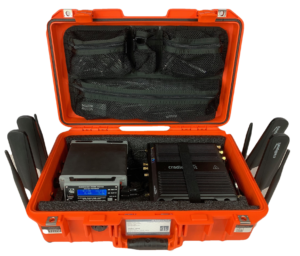
If there is one thing this pandemic has driven home is that communications capacity planning for an emergency is better done before the need hits. It’s also better if that plan is exercised periodically to remind ourselves of all the myriad details our information technology and cybersecurity personnel deal with every day to keep us securely connected. The news feeds are full of the Herculean efforts by major telecommunications companies, software and collaboration services companies, DOD and Federal Agencies, and small businesses to figure out how to turn themselves into nearly 100% teleworking organizations. Then there are the hospitals and DOD Defense Support to Civil Authorities support missions that suddenly find the need to extend networks to external locations to provide point of care solutions to those locations. Notwithstanding the growing pains, bandwidth throttling, cybersecurity issues, and successful hacks, like all networks, after some time to “burn in,” things are working. Now is the time for the IT, Cyber, and Comm folks to grab their operations officers and logistics officers, get a cup of coffee, gather around virtual conference table and write the after action reports. These should become the lessons learned and the critical purchases/current year deficiency priorities. What could have been done, done better, or not done at all, to make rapid network expansion easier and secure? What did your organization need to buy, lease, or subscribe to rapidly to get operational quickly? Would you choose different solutions now? Here are some solutions to consider:
4G Mobile Broadband Kits (MBKs) were a clear winner for the rapid response deployed capability for COVID response. Major telecommunications and cellular providers made it easy to get them by adding the MBKs to a subscriber’s bill and delivering them to their customers. These MBKs are configurable, but generally come in hardened, hand-carry Pelican cases, have configurable firewall, Virtual Private Network and other network capabilities; have 2 GB LAN/WAN port, are battery powered for 4-8 hours, and provide WiFi access for 1-50 users. These MBKs are widely used throughout US Government Agencies, Military, and Law Enforcement particularly during disaster response. 4K Solutions is the leading provider of MBKs and their products are listed on the Federal Emergency Management Agency’s approved products list.
RIVA Network’s NanoSat mobile phone network kit is another option and one that will work in areas where there is no public infrastructure to tie into. RIVA Network’s NanoSat not only comes with the cellular and satellite transmitters, network, battery-backup, and deployable case like the MBKs, RIVA Networks is a Mobile Virtual Network Operator (MVNO) with a Network Operations Center connected to the Global Roaming Alliance. They can route calls and traffic from anywhere to one’s phone. One can keep the same phone number no matter where deployed in the world. It works with all commercial satellite systems, and the cell sites are available in GSM, CDMA, 3G, 4G LTE and WiMax. It is a complete mobile solution for all mobile devices anywhere one needs to be.
If satellite access is the driving factor, Viasat’s AN/TSC-241 Multi-Mission Terminal (MMT), while a larger, but still transportable, solution, delivers IP-based voice, video, and data networks over X-, Ku-, commercial Ka-, and military Ka- bands, including operation with Viasat’s high-capacity network. A simple change of the feed arm allows allows the terminal to access the specific satellite band. Combined with a something like PacStar’s 400 Series or Smart Gateway capabilities to implement the IP network or wireless network and one can have a command operations center up and running within 30 minutes (preconfigured, of course, ahead of time).
The options available for communications and connectivity are vast beyond these three examples and the decision is an important one. A number of factors, other than costs, should go into the decision of what an organization buys/leases to be ready for an emergency. I learned these planning factors as ‘DOTMLPF’: Doctrine, Organization, Training, Material, Leadership, Personnel, and Facilities. Without getting into full details of a DOTMLPF planning process, it provides a mechanism to think through other employment considerations, including costs, and it is a process I would advise all to apply to any significant purchase or procurement to ensure that the solution meets requirements. At Quantico Tactical, we work with thousands of great vendors with products that can fit your needs, including those previously discussed. We can help you find solutions that will best fit your organization’s ability to employ it.